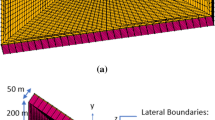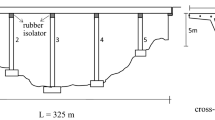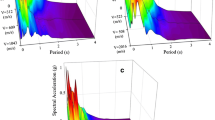Abstract
Seismic isolation is a proven strategy for protecting critical infrastructures from the damaging effects of design-level earthquake shaking. For seismically isolated highway bridges, the expected seismic performance is to provide limited service under a safety evaluation-level ground shaking with minimal to moderate damage. The behavior under extreme shaking, corresponding to a large return period seismic hazard, is not well understood and could induce significant damage. In these rare events, the seismic isolation system can be subjected to displacement demands beyond its design capacity, resulting in failure of the bearings or exceeding the clearance and pounding against the abutment backwalls. To better assess the seismic performance of a prototype highway bridge subjected to earthquakes beyond design considerations, this study examines the bridge lateral displacement, the transfer of forces to the substructure, and potential failure modes of seismically isolated bridges. Advanced modeling approaches are considered to capture bearing characteristics such as hardening for large strain, and a pounding macro-elements is implemented. Results show that for beyond design shaking, the bearings can reach the maximum shear strain capacity, significant residual deformation of the abutment can result from pounding, and the columns can experience moderate damage. The progression of damage is identified and interpreted to assess downtime.
Access provided by Autonomous University of Puebla. Download conference paper PDF
Similar content being viewed by others
Keywords
1 Introduction
Seismic isolation has proved to be an effective alternative for the design of civil infrastructure requiring high seismic performance. Seismically isolated bridges have been studied by several authors [1,2,3], showing the effectiveness of this technology through numerical simulation and experiments. Seismic codes such as Caltrans Seismic Design Criteria (Caltrans SDC) [4] provide recommendations for modeling and analyzing highway bridges in California including the use of seismic isolation. Design codes and prediction of seismic hazards have evolved over time, with notable differences among them. For instance, ASCE 7-22 [5] for buildings uses a seismic hazard associated with 2475 years return period (probability of exceedance of 2% in 50 years), while Caltrans SDC uses 975 years (probability of exceedance of 5% in 50 years). This difference in the seismic hazard design level raises concerns over the expected performance of infrastructure at the regional scale. This study examines the seismic performance of seismically isolated bridges considering shaking beyond design considerations. Maximum response and possible failure modes are predicted using advanced models to capture expected behavior.
2 Seismic Hazard
This study considers ground motions scaled to the two levels of seismic hazard corresponding to 975- and 2475-year return periods. The Unified Hazard Tool [6] was used to estimate a Uniform Hazard Spectrum (UHS) assuming a location for a bridge in Downtown Los Angeles on soil with a shear wave velocity equal to 360 m/s.
The nonlinear time-history analysis of the bridge is performed using the RotD50 [6] of thirty pairs of ground motions scaled using a target period of 2.5 s. This value is representative of effective periods between 975 and 2475 years. The records are selected using the probability of exceedance of 2% in 50 years spectral ordinate and scaled using the Conditional Spectrum methodology [7]. For the probability of exceedance of 10% in 50 years seismic hazard, the same set is downscaled by a factor of 1.4 to bring the records to the corresponding spectral ordinate. Thus, the same set of motions is used for both seismic hazards to enable a performance comparison.
3 Modeling
3.1 Prototype of Seismically Isolated Bridge
The prototype bridge was developed based on an example provided by the Federal Highway Administration Seismic Design [7] and later modified by Constantinou et al. [8] to include seismic isolation. The three-span bridge has a cast-in-place concrete box girder deck with a length of 30 m between abutments and bents and 37 m between bents in the center span. The abutment gap distance with the deck is equal to 53 cm. There is no shear key in the transverse direction that limits displacements. Bents are composed of two 6 m tall columns joined by a cap beam. Each bent abutment has two lead rubber bearings to create the isolated layer, giving an effective period of 2.13 s with effective damping of 27% associated with a design displacement of 23 cm.
3.2 Nonlinear Model
An OpenSees [9] model was developed to simulate the nonlinear behavior of the bridge. For the deck and cap beam, linear elastic elements were used considering the gross section of the elements. Three displacement-based nonlinear beam elements were used for each bent column, considering one element for each potential plastic hinge zone and another for the middle part of the column. The fiber-based section of the column elements includes unconfined concrete for the cover zone and confined concrete for the core. The footing stiffness is modeled with columns supported by linear springs for all 6 DOFs. The model proposed by Marquez et al. [10] was used for the lead rubber bearings since it captures the horizontal force resistance of rubber bearings under large strains, including strain hardening and heating effects [11]. The impact force-indentation behavior between the deck and the abutment back wall is represented by a Hertzdamp model [12] implemented in OpenSees by Hughes and Mosqueda [13]. The abutment backfill soil was modeled using the hyperbolic force-displacement model by Wilson and Elgamal [14]. Finally, for the nonlinear characterization of the abutment backwall, an Abaqus [15] model was generated to obtain the force-deformation behavior. Volumetric 8-node elements with a Concrete Damaged Plasticity material model was used to simulate concrete behavior, while truss elements considering a plastic model with isotropic hardening were defined to simulate the rebar contribution. A monotonic analysis was carried out to obtain a force-deformation curve of the abutment being pushed by a rectangular elastic block representing the deck cross-section. Figure 1 shows a scheme of the base-isolated bridge model used.
4 Results
The seismic performance of the isolated bridge is evaluated through time history analysis with the sets of motions scaled to the two hazard levels. The element response is presented in detail first for a typical record, followed by a summary of peak response for all records.
4.1 Local Element Response
Figure 2 shows the displacement orbit of the deck for both seismic hazard levels. The dashed line represents the abutment gap distance indicating that the deck pounds against the east abutment for the larger seismic hazard.
The response of the bearings at the abutment is shown in Fig. 3 for both seismic hazards in the two orthogonal horizontal directions. For the 2475 year return period, a maximum shear strain of 300% is observed, with strain hardening effects starting around 250% of shear strain deformation [10]. The peak at about −150% shear strain in the transverse direction is due to bi-directional coupling and needs to be further investigated in the model.
For 2475 years return period, the abutment response due to an impact is shown in Fig. 4a disaggregating the result in terms of the backwall and backfill soil contributions. The maximum deformation reached by the abutment is about 30 mm. The backwall reaches the maximum force capacity then fails by shear. After this point, the backfill soil contribution is negligible, but continues to increase with increasing deformation.
With respect to the bridge structural system, the most severe damage is expected at the bottom hinge in the longitudinal direction. The hysteresis for the south-east column bottom hinge is shown in Fig. 4b for both seismic hazards. The moment shown is normalized by the deck weight multiplied by the column height. The column hinge shows plastic deformation after a rotation of about 2e-3 rad, after which the moment remains relatively constant. This yield rotation θy is exceeded in both directions (positive and negative) for the beyond-design shaking, while for the design-level, it is slightly exceeded in only one direction.
4.2 Bridge System Response
The overall performance of the seismically isolated bridge is analyzed by examining the maximum response for all the records. Figure 5 shows the maximum horizontal displacement for both ground motion levels. For the following plots, the records are sorted based on the maximum orbit displacement for 2475-year motions. For 2475 year scenario, the maximum values are about twice the design-level ground motions.
The maximum rotation of the plastic hinge at the column base is shown for all records in Fig. 6a. Values are presented separately in the longitudinal and transverse direction given the different deformation behavior of the bent. In the longitudinal direction, column hinges exceed θy = 2e-3 rad. For just a few ground motions for 975 year case, while for 2475 year case, half of the ground motions exceed such threshold. However, none of the hinges showed strength degradation, therefore no severe damage to the columns is expected if the column is well confined [16]. Figure 6b shows the maximum bent displacement for longitudinal direction normalized by the maximum longitudinal deck displacement. For low demands on the column rotation, the bent contribution is high because the isolators have a high initial stiffness. At large seismic intensities, resulting in larger column rotation, the bent contribution remains around 25% as the isolators take much of the deformation. However, with increasing demands and as the hinge rotation exceed 8e-3 rad the bent contribution starts to increase reducing the effectiveness of the isolation system. As the bearings resistance continues to increase, larger forces are transferred to the columns and increase the nonlinear demands. While this behavior is expected [8] it has not been studied in detailed nonlinear analysis.
For beyond design level, 11 out of the 30 ground motions produced pounding, while for design level, no impacts are recorded. According to Wilson and Elgamal [17], the maximum load capacity of the soil can be reached at a deformation of about 0.027–0.03 times the wall height. For this bridge prototype, such a threshold is equivalent to about 76 mm, which is not reached in any of the ground motions. Beyond this value, the soil starts to lose strength.
The maximum shear strain for design level is about 300%, a value for which hardening is barely manifested and a bearing failure is unlikely according to tests for similar bearing sizes and axial stresses [18]. For beyond design shaking, four ground motions produced shear strains higher than 400%, a value for which bearing shear failure may occur [19]. One of the ground motions resulted in strain larger than 500%, which is likely to result in failure of the bearing and the models are no longer reliable.
5 Conclusions
This study assesses the performance of a seismically isolated bridge under design level and beyond design level ground shaking. For design level shaking, the isolated bridge shows good performance, with very limited nonlinear behavior at the columns and maximum shear strain in lead rubber bearings of about 300%.
For beyond design shaking, 11 of 30 ground motion pairs resulted in abutment pounding. Although several impacts indicated the potential for abutment deformations, those are below the strength degradation limit and not likely to fully develop a failure wedge. The columns moment-rotation behavior shows significant yielding but without strength degradation that was incorporated in the model. Regarding shear strain at the bearings, 4 out of 30 ground motions produced a deformation greater than 400%, which raises concerns regarding a potential limit for bearing failure.
The results show that the failure mode for a seismically isolated bridge for beyond design shaking is likely bearing failure in the transverse direction. Shear keys were not considered in the study, but it will be examined in future work.
References
Tsopelas, P., Constantinou, M.C., Kim, Y.S., Okamoto, S.: Experimental study of fps system in bridge seismic isolation. Earthq. Eng. Struct. Dyn. 2(5), 5–18 (1996)
Warn, G.P., Whittaker, A.S.: Performance estimates in seismically isolated bridge structures. Eng. Struct. 26(9), 1261–1278 (2004)
Buckle, I.G., Constantinou, M.C., Dicleli, M., Ghasemi, H.: Seismic Isolation of Highway Bridges. Multidiciplinary Center for Earthquake Engineering Research, University at Buffalo (2006)
CALTRANS: CALTRANS Seismic Design Criteria Version 2.0 State of California Department of Transportation (2019)
ASCE 7-22: Minimum Design Loads and Associated Criteria for Buildings and Other Structures. American Society of Civil Engineers (2022)
Boore, D.M.: Orientation-independent, nongeometric-mean measures of seismic intensity from two horizontal components of motion. Bull. Seismol. Soc. Am. 100(4), 1830–1835 (2010)
Mast, R., Marsh, L., Spry, C., Johnson, S., Griebenow, R., Guarre, J., Wilson, W.: Seismic Design of Bridges. Design Example No. 4: Three-Span Continuous CIP Concrete Bridge. 1st edn. National Technical Reports Library—NTIS, United States (1996)
Constantinou, M.C., Kalpakidis, I., Filiatrault, A., Lay, R.A.E.: MCEER: Earthquake Engineering to Extreme Events (2011)
McKenna, F., Scott, M.H., Fenves, G.L.: Nonlinear finite-element analysis software architecture using object composition. J. Comput. Civ. Eng. 24(1), 95–107 (2009)
Marquez, J.F., Mosqueda, G., Kim, M.K.: Modeling of lead rubber bearings under large cyclic material strains. J. Struct. Eng. 147(11) (2021)
Kalpakidis, I.V., Constantinou, M.C.: Effects of heating on the behavior of lead-rubber bearings. I: theory. J. Struct. Eng. 135(12), 1440–1449 (2009)
Lankarani, H.M., Nikravesh, P.E.: A contact force model with hysteresis damping for impact analysis of multibody systems. J. Mech. Des. 112(3), 369–376 (1990)
Hughes, P.J., Mosqueda, G.: Evaluation of uniaxial contact models for moat wall pounding simulations. Earthq. Eng. Struct. Dyn. 49(12), 1197–1215 (2020)
Wilson, P., Elgamal, A.: Full-scale shake table investigation of bridge abutment lateral earth pressure. Bull. New Zeal. Soc. Earthq. Eng. 42(1), 39–46 (2009)
Smith, M.: ABAQUS/Standard User’s Manual, Version 6.9. Dassault Systèmes Simulia Corp, United States (2009)
Priestley, M.J.N., Seible, F., Calvi, G.M.: Seismic Design and Retrofit of Bridges, 1st edn. John Wiley & Sons, United States (1996)
Wilson, P., Elgamal, A.: Large-scale passive earth pressure load-displacement tests and numerical simulation. J. Geotech. Geoenviron. Eng. 136(12), 1634–1643 (2010)
Feng, D., Chen, C., Liu, W., Tanaka, K.: A performance test study on Chinese g4 lead rubber bearings. In: 13th World Conference on Earthquake Engineering, Vancouver, Canada (2004)
Japan Nuclear Energy Safety Organization, Proposal of Technical Review Guidelines for Structures with Seismic Isolation (2013)
Acknowledgements
The authors would like to acknowledge the generous support of PEER - Pacific Earthquake Engineering Research Center. This research was funded under PBE – M7. The opinions, findings, conclusions or recommendations expressed in this publication are those of the authors and do not necessarily reflect the views of the study sponsors, Pacific Earthquake Engineering Research Center (PEER), or the Regents of the University of California.
Author information
Authors and Affiliations
Corresponding author
Editor information
Editors and Affiliations
Rights and permissions
Copyright information
© 2023 The Author(s), under exclusive license to Springer Nature Switzerland AG
About this paper
Cite this paper
Sepulveda, C., Bustamante, R., Mosqueda, G. (2023). Seismic Performance of Isolated Bridges Under Extreme Shaking. In: Cimellaro, G.P. (eds) Seismic Isolation, Energy Dissipation and Active Vibration Control of Structures. WCSI 2022. Lecture Notes in Civil Engineering, vol 309. Springer, Cham. https://doi.org/10.1007/978-3-031-21187-4_37
Download citation
DOI: https://doi.org/10.1007/978-3-031-21187-4_37
Published:
Publisher Name: Springer, Cham
Print ISBN: 978-3-031-21186-7
Online ISBN: 978-3-031-21187-4
eBook Packages: EngineeringEngineering (R0)










